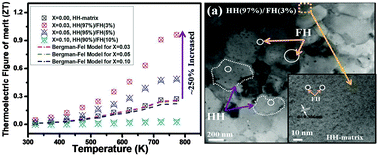Panoscopically optimized thermoelectric performance of a half-Heusler/full-Heusler based in situ bulk composite Zr0.7Hf0.3Ni1+xSn: an energy and time efficient way†
Abstract
All scale hierarchical architecturing, matrix/inclusion band alignment and intra-matrix electronic structure engineering, the so called panoscopic approach for thermoelectric materials has been demonstrated to be an effective paradigm for optimizing high ZT. To achieve such hierarchically organized microstructures, composition engineering has been considered to be an efficient strategy. In this work, such a panoscopic concept has been extended to demonstrate for the first time in the case of half-Heusler based thermoelectric materials via a composition engineering route. A series of new off-stoichiometric n-type Zr0.7Hf0.3Ni1+xSn (0 ≤ x ≤ 0.10) HH compositions have been modified to derive HH(1 − x)/full-Heusler (FH)(x) composite with an all scale hierarchically modified microstructure with FH inclusions within the matrix to study the temperature dependent thermoelectric properties. The structural analysis employing XRD, FE-SEM and HR-TEM of these materials reveal a composite of HH and FH, with hierarchically organized microstructures. In such a submicron/nano-composite, the electronic properties are observed to be well optimized yielding a large power factor; α2σ (∼30.7 × 10−4 W m−1 K−2 for Zr0.7Hf0.3Ni1.03Sn) and reduced thermal conductivity (∼2.4 W m−1 K−1 for Zr0.7Hf0.3Ni1.03Sn) yielding a high ZT ∼ 0.96 at 773 K for composition Zr0.7Hf0.3Ni1.03Sn which is ∼250% larger than the normal HH Zr0.7Hf0.3NiSn (ZT ∼ 0.27 at 773 K). The enhancement in ZT of these composites has been discussed in terms of primary electron filtering, electron injection and several phonon scattering mechanisms such as alloy scattering, point defect scattering, and grain boundary scattering. The Bergman and Fel model is used to calculate effective thermoelectric parameters of these composites for comparing the experimental results.


 Please wait while we load your content...
Please wait while we load your content...